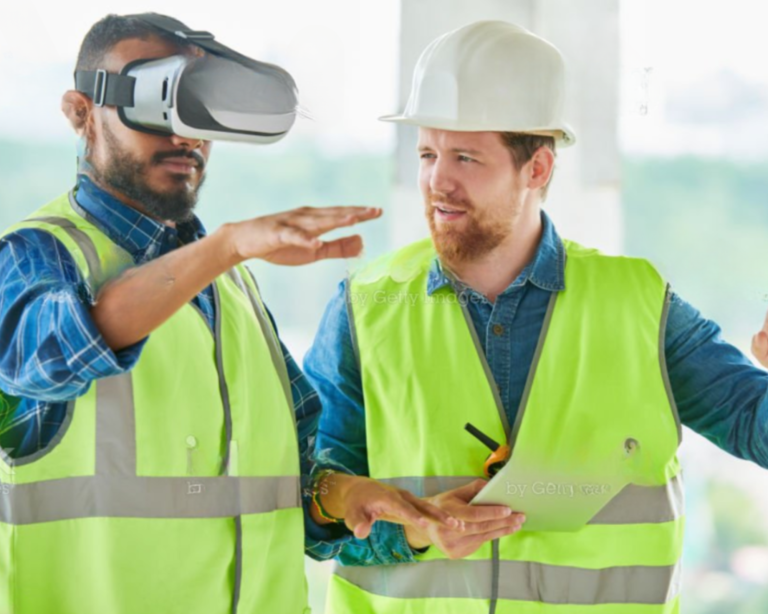Exploring the Future:
The implementation of Virtual Reality (VR) technology in the construction industry has the potential to bring about a paradigm shift in the way builders and remodelers approach their projects. One of the most significant advantages of VR technology is the ability to provide an immersive 3D representation of the building or renovation project. This feature enables builders and designers to experience the final product in unprecedented detail, allowing them to identify flaws and make changes without the costly need for prototypes. VR opens up a virtual world for us only needed a headset to transform our view. Could Virtual Reality be what the construction indusrty needs?

Virtual Reality:
Who Can Benefit from this Cutting-Edge Technology?
According to Cadcrowd.com “Everyone involved in an architectural project, whether the designer, developer or client, is considered a “user.” Typical users of VR rendering include:
- Architects. The most frequent users of VR renderings that use the expertise of a 3D architectural visualization company are architects. VR helps them share design ideas and generate constructive feedback from clients, and it communicates their vision of the project comprehensively. When technical drawings are too complicated for clients, VR rendering allows them to understand every detail almost instantly.
- Property developers. Architectural visualization is an indispensable tool for property developers when they present a project to investors or marketing companies. Realistic visualization provides the groundwork for investors to give quick approval. A comprehensive presentation also helps the marketing company craft the most appropriate strategy to attract buyers.
- Real estate agents. For those who want to sell houses, the best way to convince potential buyers is to take them for a tour of their properties. If the distance is an obstacle, transforming the physical homes into VR renderings eliminates the issue. Any client from anywhere in the world can access the digital file and take the tour at their convenience.
Homeowners. Whether homeowners plan for a renovation or a significant overhaul, VR rendering can show the results when the project is finished. As long as the construction hasn’t started yet, homeowners have limitless options to implement a specific design approach or architectural style to the project. They may need assistance from 3D rendering designers, architects, or other architectural professionals to curb the imagination and make sure the plan is technically (and financially) possible.”
Exploring the Virtual Reality Creation Process:
A Step-by-Step Guide
The process of using VR in home design involves three simple steps: planning, designing, and showcasing.
- First, the designer listens to the client’s needs and preferences and creates a basic plan for the space.
- Next, the designer uses specialized software and VR tools to create a realistic 3D model of the space.
- Finally, the designer showcases the space to the client in VR, allowing them to see and experience the design in a fully immersive way.
VR not only allows homeowners to visualize their desired space but also helps designers to identify potential issues or improvements before construction.
Cost
Breaking Down the Cost of Virtual Reality
You might be wondering about the potential costs involved. Well, at the lower end of the spectrum, a firm may charge between $2 and $5 per square foot. Considering that the average size of a single-family house in the United States is slightly more than 2,200 square feet, it means that if homeowners choose the lowest price, the rendering still costs around $4,400.
Of course, the cost might vary depending on the type and area of the building as well. For instance, if you’re in South Carolina, home building costs range between $300 to $700 per square foot.
Spotting Trends:
Examining the Latest Phenomenon in Today's World".
In 2019, Valley Construction Company, in Arizona has taken a pioneering initiative by embracing Virtual Reality technology into their designing process. By implementing the use of VR, Valley Construction is able to offer a 3D outlook of their designs to get a full sense of what the school would look like. This has allowed them to avoid costly mistakes whilst making any changes required on the design, resulting in significant savings, savings that would have otherwise come from the taxpayers’ pockets.
Valley Construction Company is setting an example of exactly how technology can be used to streamline construction, making hardware and software tools available to smooth the construction process, right from the design phase to the final construction phase.
Wrapping it up:
It’s amazing to see how VR technology has the potential to revolutionize the construction industry! It can greatly reduce costs, improve efficiency, and enhance safety with its immersive and interactive capabilities.
In addition, the current COVID-19 pandemic has made remote collaboration a necessity, making VR adoption even more essential. Although there are certain challenges, such as the cost of the hardware and software, the need for skilled technicians, and the limitations of current VR technology, it should be noted that progress is being made, making it a promising tool that can significantly improve the construction industry’s productivity, sustainability, and competitiveness in the future. I’m excited yet curious to see if VR has the potential to be the future.
